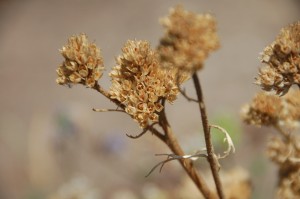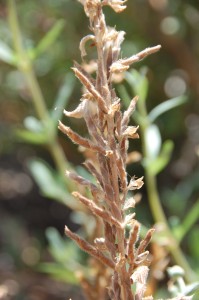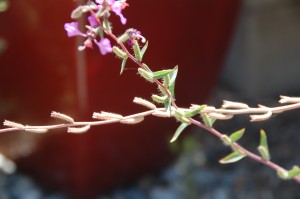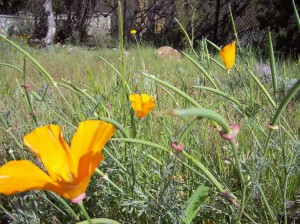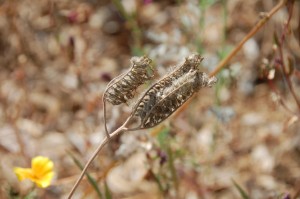What do Wildflowering L.A. sites look like as they go to seed, as all sites are right now? Join us to collect some seeds and take a bit of the project home at the final event in the Wildflowering L.A. project cycle at Site #32, on the UCLA Campus at Sage Hill on Sunday, June 15th from 2-4pm.
Yes, that’s Father’s Day – so bring your gardening-loving dad to collect seeds and participate in the screening of the MOCA TV short documentary on about Wildflowering L.A., tracing the project from its planting through to its seasonal conclusion.
A sampling with images is below to help you distinguish and collect onsite, contributed by Theodore Payne Foundation’s Genny Arnold. For even more information, check out this handout with tips on seed collecting.
Gilia capitata (Globe Gilia) – This member of the Polemoniaceae, or phlox family, forms capsules as it goes to seed. Each section of the inflorescence contains up to three seeds.
Lupinus truncatus (Collared Annual Lupine) – This member of the Fabaceae, or legume family, produces a pod-style fruit. Upon ripening, the pods open to release the seed. A helpful hint for harvesting seed of lupines– a short stocking may be carefully tied over the ripening fruits so that when the pod opens the seed is captured (the aerated material of a stocking is appropriate because it will not cause anaerobic situation wherein mold might form).
Clarkia unguiculata (Elegant Clarkia) – This member of the Onagraceae, or evening primrose family, forms capsules up and down the length of its stem where the flowers once were. Upon ripening, the capsules will be tan and dry and will open slightly at the top, as pictured in the horizontal branch. If the capsules are green, as pictured in the vertical branch, they are not ready for harvest.
Eschscholzia californica (California Poppy) – Members of the Papaveraceae, or poppy family, form seed capsules. In this photo, the elongated capsules are still very green and therefore not ripe. When ripe, they will turn tan and become crisp; upon maturity, the pop open and release the seeds.
Phacelia tanacetifolia (Lacy Phacelia) – This member of the Boraginaceae, or waterleaf family, turns completely brown when its seed capsules are ripe. If you harvest this one, please wear gloves; it has micro-hairs that can cause mild contact dermatitis.


